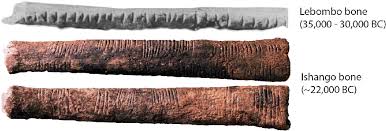
Have you ever heard of the Lebombo Bone? It is even older than the Ishango bone. It is indeed the oldest known mathematical artifact in the world. Discovered in the 1970s in Border Cave, a rock shelter on the western scarp of the Lebombo Mountains in an area near the border of South Africa and Swaziland (now Eswatini). The bone was found on the Eswatini side, and dates from 35,000 BC. It consists of 29 distinct notches that were deliberately cut into a baboon’s fibula.
The bone is between 44,200 and 43,000 years old, according to 24 radiocarbon datings. This is far older than the Ishango bone with which it is sometimes confused. Other notched bones are 80,000 years old but it is unclear if the notches are merely decorative or if they bear a functional meaning.
According to The Universal Book of Mathematics, the Lebombo bone’s 29 notches “may have been used as a lunar phase counter, in which case African women may have been the first mathematicians, because keeping track of menstrual cycles requires a lunar calendar.” However, the bone is clearly broken at one end, so the 29 notches may or may not be a minimum number. In the cases of other notched bones since found globally, there has been no consistent notch tally, many being in the 1–10 range. The Lebombo bone resembles a calendar used by the early men of the area, coming from the San clans of Namibia; this way of making tallies is still used by the San people today.

According to The Universal Book of Mathematics, the Lebombo bone’s 29 notches “may have been used as a lunar phase counter, in which case African women may have been the first mathematicians, because keeping track of menstrual cycles requires a lunar calendar.” However, the bone is clearly broken at one end, so the 29 notches may or may not be a minimum number. In the cases of other notched bones since found globally, there has been no consistent notch tally, many being in the 1–10 range. This resembles a calendar used by the early men of the area, coming from the San clans of Namibia. These represent the earliest unambiguous evidence for modern human behavior. An article in the Proceedings of the National Academy of Sciences (PNAS) on recent archaeological discoveries, “Early evidence of San material culture represented by organic artifacts from Border Cave, South Africa” , has shown that bone tools were already present 75,000 years ago and were used in San culture.
To anyone who ever doubted it, Africa is indeed the cradle of humanity… and women (if it is indeed a lunar tool) were quite advanced mathematicians 35,000 years ago, using calculators to make lunar calendars!


Proof positive that the innovators and originators came from the motherland. I didn’t even know about those bones or how they were used in an educational context. Well, now I know!
LikeLiked by 1 person
Great!
LikeLiked by 1 person
Yup. I think it’s really cool how they taught math to people back then before calculators or apps.
LikeLike
Africa is the place where human was born on the first, isn’t it?
LikeLike
I have linked to this page from https://en.wikipedia.org/wiki/Lebombo_bone
because it has the great images
If you know the copyright holders you may be could put the images up at wikipedia
You could even put the various encyclopedic info on your blog there – that would be great
LikeLike
Thank you Chad, I will do as you suggested, and thank you for linking to this article. Truly appreciated.
LikeLike
you do lots of great work – sorry about the repeat (logging in issues)
LikeLike
I have linked to this page from https://en.wikipedia.org/wiki/Lebombo_bone
because it has the great images
If you know the copyright holders you may be could put the images up at wikipedia
You could even put the various encyclopedic info on your blog there – that would be great
LikeLike
Pingback: A Few Glimpses of the Real Lives of our Ancestors, by Starstuff, Contemplating | Humanistic Paganism
Pingback: Ospreyshire Origins: Lebombo | Ospreyshire's Realm
Pingback: History of Numbers & Number Systems – NUMBER'S WORLD
Pingback: An African Moon | Makweti
Pingback: Tulang Lebombo – Alat Matematika dari Afrika – Mahasiswa Baru